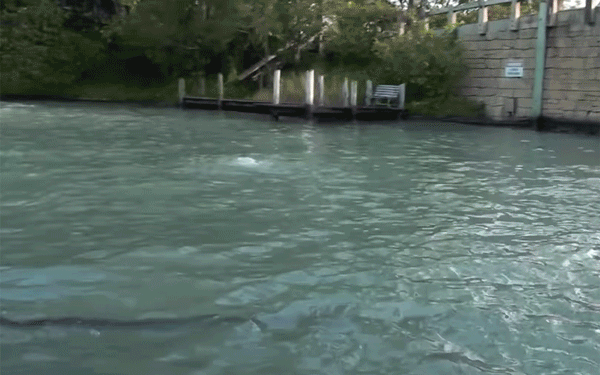
When Robb Alvey, an amusement park fanatic, heard that Universal Studios Orlando was shuttering its beloved “Jaws”-themed ride in 2012, he made sure to grab a front-row seat for the closing day.
Using a hand-held digital camera, he filmed the six-minute boat ride: from the skipper Jacob welcoming passengers; to the “mayday” distress call; to the first sighting of the prosthetic shark; to the grenade launchers and exploding fireballs; and, finally, to the “high-voltage” cable that fries the animatronic beast.
Mr. Alvey, 49, who lives in Orlando, Fla., and runs a website called Theme Park Review, uploaded the footage to YouTube. Seven years later, the video has been viewed more than 160 million times.
“This was better than the actual movie,” one of the thousands of commenters wrote. Another recalled thinking the mechanical monster was real as a child. “It’s sad this ride is gone,” another lamented.
Thanks to park archivists like Mr. Alvey, no theme park truly disappears anymore. The “Jaws” clip is just one in the thriving genre of “last-ride” videos, in which the final moments of amusement park attractions are chronicled for posterity.
Thrill seekers can ride shotgun on a raft and dodge a roaring T. rex on Universal Hollywood’s “Jurassic Park”: The Ride. Or see a simulated tornado destroy an Oklahoma town at Universal Florida’s “Twister” … Ride It Out. Or journey past recreated movie sets from “Alien” and “The Wizard of Oz” at The Great Movie Ride, which operated for almost three decades at Walt Disney World in Orlando.
All of these attractions, and dozens more, are still running — at least virtually — in this alternate universe of last-ride videos.
Nostalgia plays a big role, said Jason Sheridan, a host of “Podcast: The Ride,” which chronicles old and new attractions. “People have positive associations of when they first went to a park as a kid,” said Mr. Sheridan, 34, an actor and writer who lives in Los Angeles. “They think, ‘Oh, this stuff will be there forever.’ So when Disney re-themes a ride, they feel a little melancholy.”
And in an age of digital thrills, when so much entertainment is mediated through a screen, vintage theme-park footage clips allow viewers to re-experience the tactile, hands-on joys of their favorite ride — albeit also through a screen.
“It’s a truly irreplaceable medium,” said Kevin Perjurer, a filmmaker in Orlando who specializes in amusement parks. “When a theme park ride is destroyed, it’s gone for good.”
While last-ride videos offer a keepsake of bygone thrills, the public’s fascination with theme parks has also given rise to a cottage industry of podcasts, books, websites and documentaries.
Mr. Perjurer is the creator of “Defunctland,” a YouTube series that documents the rise and fall of former wonders such as Disney’s “20,000 Leagues Under the Sea”: Submarine Voyage ride in Orlando, Six Flags AstroWorld in Houston, Tex., and Universal’s “Kongfrontation.” The documentary series, which began in 2017, has more than half a million subscribers.
Roland Betancourt, an associate professor of art history at the University of California, Irvine, said that theme parks offer a kind of parallel universe that is rich with lore and fantasy. “Theme parks are a unique cultural space,” said Mr. Betancourt, who teaches classes about Disneyland’s design and history. “They aim for utopias that are never quite fully present. They represent a continued desire to unsettle time and space through art and architecture, to produce a sense of place that is never quite fully realized.”
The obsession with certain rides can lead to extreme pursuits.
Chris Wallace, a 38-year-old technologist, visited Disney World in Orlando frequently as a child, but he never got to experience Epcot’s Horizons, a ride that offered a futuristic look at 21st century living (as predicted in 1983). So he recreated Horizons as a 360-degree computer animation. Using online video and blueprints, Mr. Wallace programmed a digital rendering of the 15-minute long ride, including the “Futureport Departure” sign that greeted visitors and the Jetsons-like robot that vacuumed the floor.
“People will write and say, ‘I used to ride this with my grandfather before it closed, and it makes me feel like I’m getting to do it all over again with him,’” Mr. Wallace said. “Everybody has a story of what it meant to them.”
That longing for expired rides is certain to increase in coming years, as America’s theme parks are renovated: In August, Disney announced that Epcot will undergo yet another major overhaul, while Universal Orlando recently revealed plans for a massive new park called Epic Universe.
And when parks make big changes, the charmingly antiquated rides are often first to go. In 2014, Walt Disney World shuttered its Studio Backlot Tour, a behind-the-scenes look at movie production, to make room for “Star Wars”: Galaxy’s Edge, a blockbuster attraction that opened this year.
“The backlot tour was over two hours long, and took up a big part of your day, but it showed you every aspect of filmmaking,” said Alicia Stella, 37, a journalist who covers theme parks on her website Orlando ParkStop. “I miss those kinds of attractions. A lot of the new ones are fast-paced thrill rides.”
Such expansions are a reminder that the parks are in a constant state of evolution, which makes the archivists’ efforts all the more crucial: You never know when your favorite ride could close for good.







